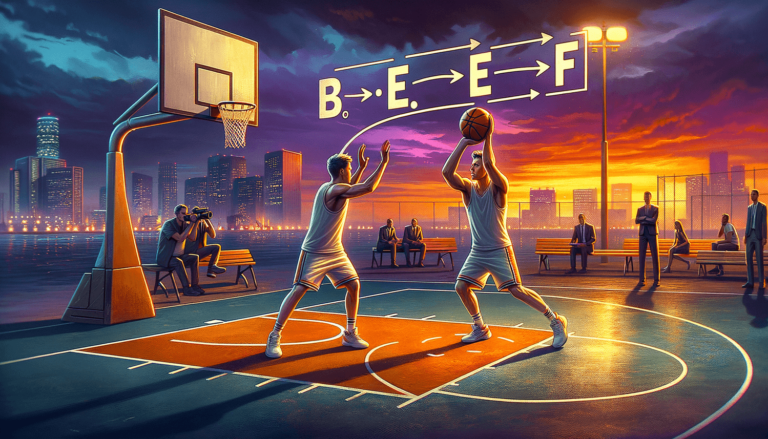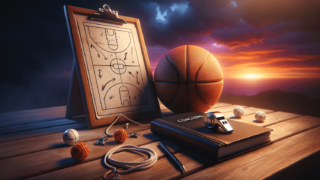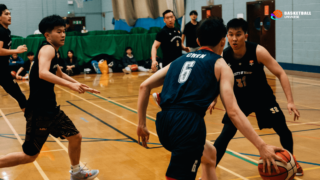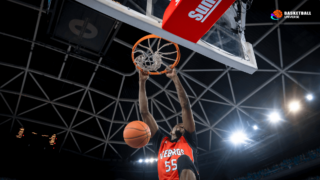
What Does B.E.E.F Mean in Basketball?
Written by: Basketball Universe
Last updated:

If you’ve ever found yourself scratching your head at the mention of ‘B.E.E.F’ in basketball, worry no more, because we’ve got the juicy details! If your mind is rushing to thoughts of barbecues and steakhouses, we’re here to tell you that it’s actually an easy-to-remember mnemonic that refers to a fundamental aspect of the game – shooting technique. In this fun and professional blog post, you’ll uncover the four essential elements that make up B.E.E.F and learn how mastering this unconventional yet effective acronym can help elevate the shooting skills of both beginners and seasoned players alike. So grab your dribble, and let’s beef up your basketball skills!
What Does B.E.E.F Mean in Basketball?
B.E.E.F is an acronym in basketball that represents the four fundamental elements of a proper shooting technique: Balance, Eyes, Elbow, and Follow-through. By focusing on and mastering these elements, players can improve their shooting accuracy and overall performance on the court.
Breaking Down B.E.E.F: The Key to Better Shooting
Anyone who’s a fan of basketball knows that the art of shooting is crucial for success in the game. A fundamental technique, B.E.E.F, can help transform your shooting skills, leading to better on-court performance. In this in-depth guide, we’ll explore each component of the B.E.E.F acronym, offering valuable insights and practical tips that you can apply immediately to improve your game. Ready to become a basketball shooting star? Read on!
B – Balance: The Steady Foundation
Balance is the cornerstone of the B.E.E.F acronym – it’s the foundation upon which your shooting form is built. When your body is in balance, you’re more likely to execute a smooth shot, resulting in increased accuracy and consistency. Here’s how to achieve the perfect balance:
Footing: Shoulder-width Apart
Ensure that your feet are approximately shoulder-width apart when you’re getting ready to shoot. This stance provides a solid base, fortifies your balance, and allows you to jump vertically without any lateral movement that can affect your shot’s precision.
Foot Position: Dominant Foot Forward
The placement of your feet is key to enhancing your balance. Your dominant foot (the same side as the hand you shoot with) should be slightly in front of the other foot, turned about 45 degrees toward the basket. This forward position allows you to maintain equilibrium during your shot and maintain a comfortable posture.
Weight Distribution: Centered
Distribute your body weight evenly between your feet, with your knees slightly bent. This centered weight distribution enables you to move fluidly while shooting and reduces the likelihood of being thrown off balance by unexpected movements or contact from defenders.
E – Eyes: Focus on the Target
As the saying goes, “You can’t hit what you can’t see.” In basketball, this principle remains true – your eyes are a crucial component of successful shooting. Here’s how to optimize your visual targeting:
Identify the Target: Find the Sweet Spot
Locate the sweet spot on the backboard, just above the rim. This is the optimal location to aim for when shooting. By consistently focusing on this sweet spot, you successfully train your muscle memory, leading to improved accuracy over time.
Maintain Visual Consistency: Keep Your Sights Steady
Once you’ve identified the sweet spot, maintain visual consistency by keeping your eyes locked onto it throughout the entirety of your shot. This unwavering focus enables you to better align your body and gauge the distance and arc necessary for a successful attempt.
E – Elbow: Align for Accuracy
The alignment of your elbow is another integral component of the B.E.E.F shooting technique. Here’s how to ensure that your elbow is perfectly positioned for success:
Elbow Position: In-line with Your Knee and Foot
Your shooting arm’s elbow should be in line with your knee and foot, forming a straight line perpendicular to the floor. This alignment ensures that your arm moves in a natural, efficient motion and is crucial for achieving a smooth shot with accuracy.
Elbow Angle: 90 Degrees
As you prepare to shoot, bend your arm to create a 90-degree angle at your elbow. This angle allows you to generate adequate power and control while maintaining a consistent release point during the shooting motion.
Elbow Lift: Steady and Controlled
As you begin your shot, lift your elbow in a steady, controlled motion. Keep your arm close to your body to ensure that your motion is fluid and linear. This upward lift, coupled with the proper angle and alignment, will result in a smooth release and accurate shot.
F – Follow-Through: Finish with Finesse
The follow-through is the culmination of all the components of the B.E.E.F technique, often referred to as the “finesse” part of the shot. A proper follow-through ensures smooth, controlled motion and optimal accuracy. Here’s how to polish your follow-through:
Shooting Hand: Extend and Snap
Extend your shooting arm fully, finishing with a snap of the wrist. This follow-through motion imparts backspin on the ball, enhancing its stability during flight and increasing the likelihood of successfully making the shot.
Shooting Fingers: Downward and Relaxed
Upon completing the wrist snap, your shooting fingers should be pointing downward, and your hand should be relaxed. This positioning enforces a smooth follow-through and contributes to a soft, controlled shot.
Non-shooting Hand: Steady Support
Your non-shooting hand plays a crucial support role during your shot. As you release the ball, slight separation should be present between both hands. This ensures that your non-shooting hand doesn’t push or steer the ball, affecting its trajectory or spin.
Putting B.E.E.F into Practice: Drills and Exercises
Now that you have a comprehensive understanding of the B.E.E.F technique in basketball, it’s time to put that knowledge into action. Refining your shooting fundamentals via targeted drills and exercises can help you transform your game and increase your shooting prowess. Here are some helpful training approaches:
The Form Shooting Drill
This drill reinforces the correct shooting form and technique in every aspect, from positioning to follow-through. By practicing form shooting at a close distance from the basket, you can normalize the proper mechanics and gradually improve your accuracy as you step back farther from the hoop.
The “One and Done” Drill
In this drill, you shoot just one attempt from a series of spots around the three-point arc, forcing you to focus intensely on each shot’s accuracy. With only one chance from each spot, you’re challenged to consistently execute the elements of B.E.E.F, honing your technique under pressure.
The “Around the World” Drill
Like the “One and Done” drill, the “Around the World” exercise involves shooting from a series of spots around the arc. However, in this variation, you must make a shot from each spot before moving on to the next. The ultimate goal is to successfully shoot from every position without missing more than twice in a row. This drill incorporates mental focus and game-like challenges, sharpening the application of B.E.E.F in a competitive setting.
With dedicated practice and attention to each of the B.E.E.F components, you can transform your basketball shooting technique and open up new opportunities for success on the court. So don’t wait – start incorporating this powerful acronym into your game today!
Taking B.E.E.F Technique to the Next Level: Expanding Your Skills
Now that you have a deep understanding of the B.E.E.F acronym and how to apply it to your basketball game, it’s time to explore some advanced techniques and strategies that can elevate your shooting to even greater heights. By building upon the fundamentals, you can gain an edge over your competition and prepare yourself for whatever challenge the court may bring.
Adjusting B.E.E.F for Different Types of Shots
While maintaining the B.E.E.F technique as a core component of your shooting, some adaptations may be necessary to accommodate various shot types in basketball. Here are some tips on how you can adjust your B.E.E.F skills for specific types of shots:
Jump Shots
When taking a jump shot, timing is crucial. After achieving perfect balance and aligning your elbow, elevate with a strong jump and release the ball at the top of your jump. Maintain the focus with your eyes and ensure a consistent follow-through to maintain accuracy even when jumping off the ground.
Free Throws
Since free throws grant you more time and space, take advantage of this by establishing an even stronger foundation in your balance, elbow alignment, and follow-through. Develop a simple, repeatable pre-shot routine to calm yourself and relieve pressure, making sure that consistency in technique leads to success at the free-throw line.
Bank Shots
For bank shots, focus on a different target – the point on the backboard where you want the ball to hit before dropping into the hoop. As your eyes reposition, the remaining elements of the B.E.E.F formula stay consistent, allowing you to execute accurate and effective bank shots.
Strategies to Improve Shooting Under Pressure
Game situations can introduce stress and pressure, making it more challenging to maintain the fundamentals of the B.E.E.F technique. Here are some strategies to ensure that you keep your cool and stick to the basics even when the game is on the line:
Mental Preparation
Develop a solid mental game by employing visualization techniques and positive self-talk to reinforce your confidence in taking — and making — crucial shots. This mental fortitude will help you better execute your B.E.E.F components and build resilience even under pressure.
Practice with Purpose
Incorporate high-pressure scenarios into your practice regimen, simulating game-like situations where you have to make important shots while fatigued or with a defender challenging you. This purposeful practice can help you maintain your B.E.E.F technique and handle pressure with ease.
Embrace the Challenge
Pressure situations are a chance for you to thrive and show your skills under pressure. Learn to welcome these moments and use them as an opportunity to test your B.E.E.F abilities and showcase your talent on the court.
By expanding your B.E.E.F technique to include advanced shooting strategies and cultivating mental resilience, you can maintain your shooting prowess in a variety of game settings and situations. Focus on honing these additional skills, and watch your basketball talents soar even higher.
Frequently Asked Questions (FAQ)
As you progress in your journey of learning and implementing the B.E.E.F technique, you might have some questions along the way. That’s why we’ve compiled this FAQ section to help answer some of the most common queries related to B.E.E.F in basketball. Take a look below to find the answers you may be seeking:
1. How long does it take to master the B.E.E.F technique?
The time required to master the B.E.E.F technique varies with each individual’s skill level, dedication, and practice habits. With consistent practice and a commitment to mastering fundamentals, most players can see significant improvements in their shooting technique within a few weeks to a few months.
2. Can the B.E.E.F technique be applied to all types of shots in basketball?
Yes, the B.E.E.F technique serves as a universal foundation for different types of basketball shots. Some elements may need slight adjustments to cater to specific shots (such as jump shots or bank shots), but the overall structure remains consistent across all shooting situations.
3. Is the B.E.E.F technique suitable for players at all skill levels?
Absolutely! The B.E.E.F technique is ideal for beginners who are learning fundamentals as well as experienced players who want to fine-tune their shooting form. It serves as a valuable guide for players at all skill levels to improve their shooting accuracy and consistency.
4. How can I practice the B.E.E.F technique on my own?
Shooting drills, such as form shooting, “One and Done,” and “Around the World,” can be practiced individually to help you focus on each component of the B.E.E.F technique. Dedicate time to practice each of the four elements separately, then gradually integrate them to create a smooth and comprehensive shooting motion.
5. Can I use the B.E.E.F technique for shooting three-pointers?
Yes, the B.E.E.F technique can be applied to shooting three-pointers. While the overall motion remains the same, shooting from beyond the arc may require additional leg strength and power. Maintain balance and a steady follow-through to increase your accuracy from long range.
6. How can I teach the B.E.E.F technique to children or other beginners?
Introducing the B.E.E.F technique to children and beginners requires breaking down each element into easy-to-understand instructions. Focus on one component at a time, using clear demonstrations and step-by-step guidance to help them grasp the fundamentals. Incorporate fun drills and exercises that emphasize each aspect of the technique to solidify their understanding as they develop their shooting skills.
7. Can the B.E.E.F technique help improve my free throw shooting percentage?
Yes, applying the B.E.E.F technique to your free throw shooting can lead to improved accuracy and consistency. By developing a solid pre-shot routine and maintaining balance, eye contact, proper elbow positioning, and a strong follow-through, you can significantly enhance your performance at the line.
8. Is the B.E.E.F technique useful in other sports, like volleyball or badminton?
While the B.E.E.F technique is primarily designed for basketball, some aspects of the acronym can be applied to other sports. Balance, for example, is a crucial element in most athletic movements. Although the specifics may differ, the B.E.E.F approach can serve as a starting point for understanding key fundamentals in other sports.
9. How can I keep my B.E.E.F technique consistent under pressure?
To maintain consistency under pressure, develop a strong mental game through visualization techniques and positive self-talk. Incorporate high-pressure scenarios into your practice, and learn to embrace challenges on the court. This helps build resilience and enables you to execute your B.E.E.F components even in the most demanding situations.
10. Can the B.E.E.F technique help prevent shooting slumps?
The B.E.E.F technique can be valuable in reducing the occurrence and duration of shooting slumps. By adhering to proper fundamentals, you can maintain consistency and avoid common errors that result in poor shooting performance. Regular practice and form assessment can help you identify and correct any deviations from the B.E.E.F guidelines.
11. Is the B.E.E.F technique the only method for improving shooting?
While the B.E.E.F technique is a widely-accepted and effective method, it is not the only approach for improving shooting. There are variations on shooting fundamentals that might work better for individual players based on their unique strengths and weaknesses. However, B.E.E.F remains a valuable starting point and reference for players seeking to enhance their shooting skills.
12. What are some common mistakes players make while implementing the B.E.E.F technique?
Common mistakes include poor balance, incorrect foot positioning, inadequate elbow alignment, and inconsistency in follow-through. Avoid these errors by focusing on each of the B.E.E.F components and incorporating targeted drills to address specific shortcomings in your shooting technique.
13. How does the B.E.E.F technique improve my overall basketball game?
By mastering the B.E.E.F technique, you can unlock new scoring opportunities, command greater respect from defenders, and contribute more effectively to your team’s offense. This improved shooting ability can build confidence and enhance your success rate across various game situations and court locations.
Featured Posts
- No pillar pages found.




